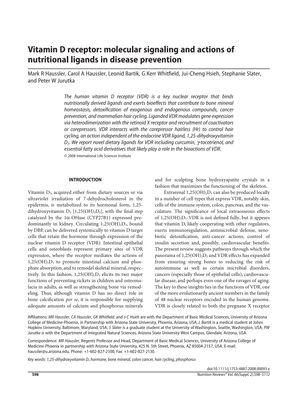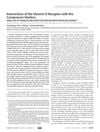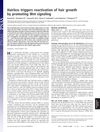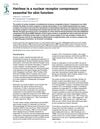Vitamin D receptor: molecular signaling and actions of nutritional ligands in disease prevention
September 2008
in “Nutrition reviews”

TLDR Vitamin D receptor interacts with certain dietary components to help prevent diseases and regulate hair growth.
The document from 2008 discusses the role of the vitamin D receptor (VDR) in various biological processes, including maintaining bone mineral balance, detoxification, cancer prevention, and regulating hair growth. It explains that VDR functions by binding with dietary ligands and influencing gene expression through its interaction with the retinoid X receptor and various coactivators or corepressors. Specifically, VDR's interaction with the corepressor hairless (Hr) is noted to be crucial for hair cycling, and this function is independent of the VDR's endocrine ligand, 1,25-dihydroxyvitamin D(3). Additionally, the document identifies new dietary ligands for VDR, such as curcumin, gamma-tocotrienol, and derivatives of essential fatty acids, suggesting these compounds may be important for VDR's biological actions.
View this study on academic.oup.com →
Cited in this study

research Interactions of the Vitamin D Receptor with the Corepressor Hairless
Most Hairless gene mutations reduce its ability to work with the Vitamin D Receptor, which might explain a certain type of hair loss.
research Hairless Suppresses Vitamin D Receptor Transactivation in Human Keratinocytes
Hairless protein can block vitamin D activation in skin cells.

research Hairless triggers reactivation of hair growth by promoting Wnt signaling
The HR protein helps hair grow by blocking a hair growth inhibitor, aiding in hair follicle regeneration.
research The Nuclear Vitamin D Receptor: Biological and Molecular Regulatory Properties Revealed
The vitamin D receptor is crucial for bone health and affects various body systems, with mutations potentially leading to disease.
Related

research Hairless is a nuclear receptor corepressor essential for skin function
Hairless protein is crucial for healthy skin and hair, and its malfunction can cause hair loss.